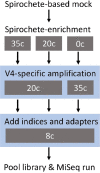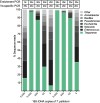A Metataxonomic Tool to Investigate the Diversity of Treponema
- PMID: 31552004
- PMCID: PMC6746968
- DOI: 10.3389/fmicb.2019.02094
A Metataxonomic Tool to Investigate the Diversity of Treponema
Erratum in
-
Corrigendum: A Metataxonomic Tool to Investigate the Diversity of Treponema.Front Microbiol. 2019 Nov 8;10:2581. doi: 10.3389/fmicb.2019.02581. eCollection 2019. Front Microbiol. 2019. PMID: 31762772 Free PMC article.
Abstract
The genus Treponema contains a number of human and animal pathogenic as well as symbiotic bacteria that are found in vastly different anatomical and environmental habitats. Our understanding of the species range, evolution, and biology of these important bacteria is still limited. To explore the diversity of treponemes, we established, validated, and tested a novel metataxonomic approach. As the informative nature of the hypervariable regions of the 16S rRNA gene differ, we first analyzed each variable region independently. Considering the in silico results obtained, we established and validated the sequencing of the V4-region of the 16S rRNA gene using known mixtures of Treponema species as well as a selected number of clinical samples. The metataxonomic approach was able to identify Treponema to a near-species level. We demonstrate that using a spirochete-specific enrichment, our method is applicable to complex microbial communities and large variety of biological samples. The metataxonomic approach described provides a useful method to unravel the full diversity and range of Treponema in various ecosystems.
Keywords: 16S rRNA; Potorous; Treponema; marsupial; metagenomics; metataxonomics; one health; spirochete.
Figures




Similar articles
-
Corrigendum: A Metataxonomic Tool to Investigate the Diversity of Treponema.Front Microbiol. 2019 Nov 8;10:2581. doi: 10.3389/fmicb.2019.02581. eCollection 2019. Front Microbiol. 2019. PMID: 31762772 Free PMC article.
-
rpoB, a promising marker for analyzing the diversity of bacterial communities by amplicon sequencing.BMC Microbiol. 2019 Jul 29;19(1):171. doi: 10.1186/s12866-019-1546-z. BMC Microbiol. 2019. PMID: 31357928 Free PMC article.
-
Development of an Analysis Pipeline Characterizing Multiple Hypervariable Regions of 16S rRNA Using Mock Samples.PLoS One. 2016 Feb 1;11(2):e0148047. doi: 10.1371/journal.pone.0148047. eCollection 2016. PLoS One. 2016. PMID: 26829716 Free PMC article.
-
Genetics of human and animal uncultivable treponemal pathogens.Infect Genet Evol. 2018 Jul;61:92-107. doi: 10.1016/j.meegid.2018.03.015. Epub 2018 Mar 22. Infect Genet Evol. 2018. PMID: 29578082 Review.
-
[Incidence and significance of treponemes in animals].Berl Munch Tierarztl Wochenschr. 2005 Jan-Feb;118(1-2):24-36. Berl Munch Tierarztl Wochenschr. 2005. PMID: 15690633 Review. German.
Cited by
-
Honeybee gut bacterial strain improved survival and gut microbiota homeostasis in Apis mellifera exposed in vivo to clothianidin.Microbiol Spectr. 2024 Oct 3;12(10):e0057824. doi: 10.1128/spectrum.00578-24. Epub 2024 Aug 27. Microbiol Spectr. 2024. PMID: 39189755 Free PMC article.
-
Dietary Contamination with a Neonicotinoid (Clothianidin) Gradient Triggers Specific Dysbiosis Signatures of Microbiota Activity along the Honeybee (Apis mellifera) Digestive Tract.Microorganisms. 2021 Nov 2;9(11):2283. doi: 10.3390/microorganisms9112283. Microorganisms. 2021. PMID: 34835409 Free PMC article.
-
Characterization of Metagenome-Assembled Genomes and Carbohydrate-Degrading Genes in the Gut Microbiota of Tibetan Pig.Front Microbiol. 2020 Dec 23;11:595066. doi: 10.3389/fmicb.2020.595066. eCollection 2020. Front Microbiol. 2020. PMID: 33424798 Free PMC article.
-
Effects of E scherichia coli Nissle 1917 on the Porcine Gut Microbiota, Intestinal Epithelium and Immune System in Early Life.Front Microbiol. 2022 Feb 25;13:842437. doi: 10.3389/fmicb.2022.842437. eCollection 2022. Front Microbiol. 2022. PMID: 35283814 Free PMC article.
-
Effects of Licorice Stem and Leaf Forage on Growth and Physiology of Hotan Sheep.Animals (Basel). 2025 May 18;15(10):1459. doi: 10.3390/ani15101459. Animals (Basel). 2025. PMID: 40427336 Free PMC article.
References
LinkOut - more resources
Full Text Sources
Research Materials

